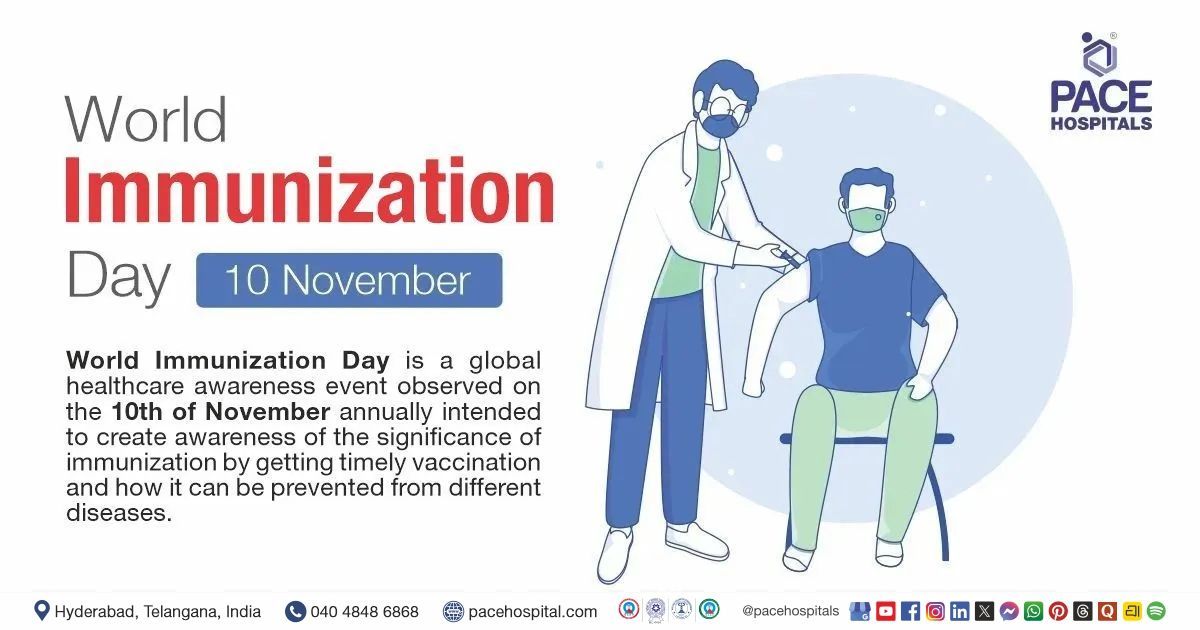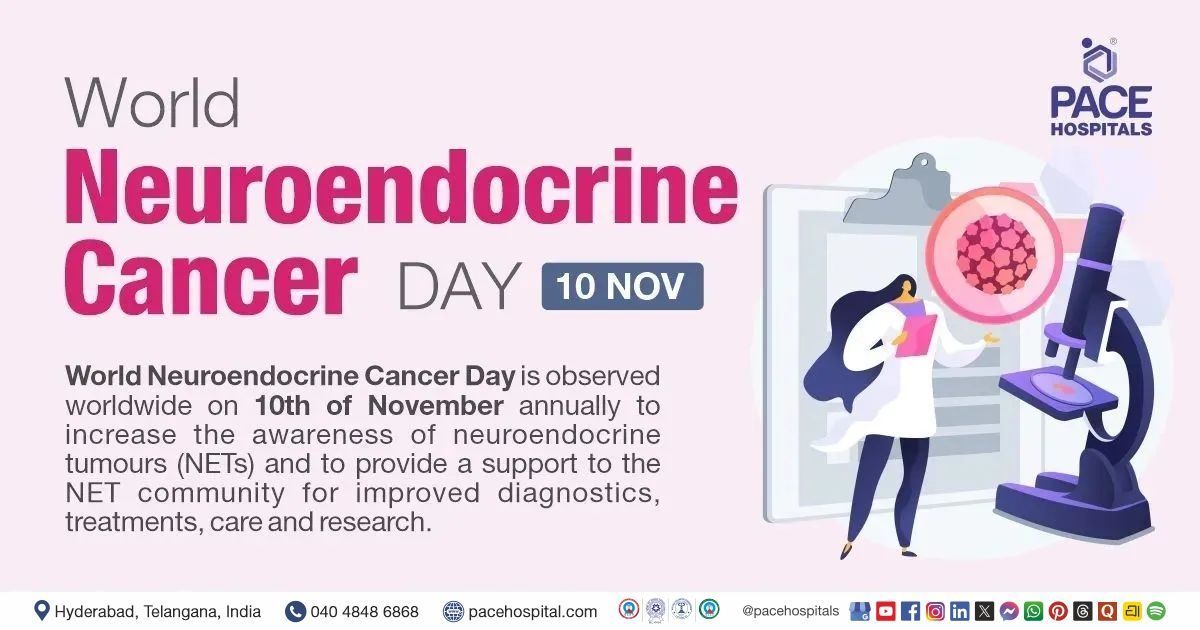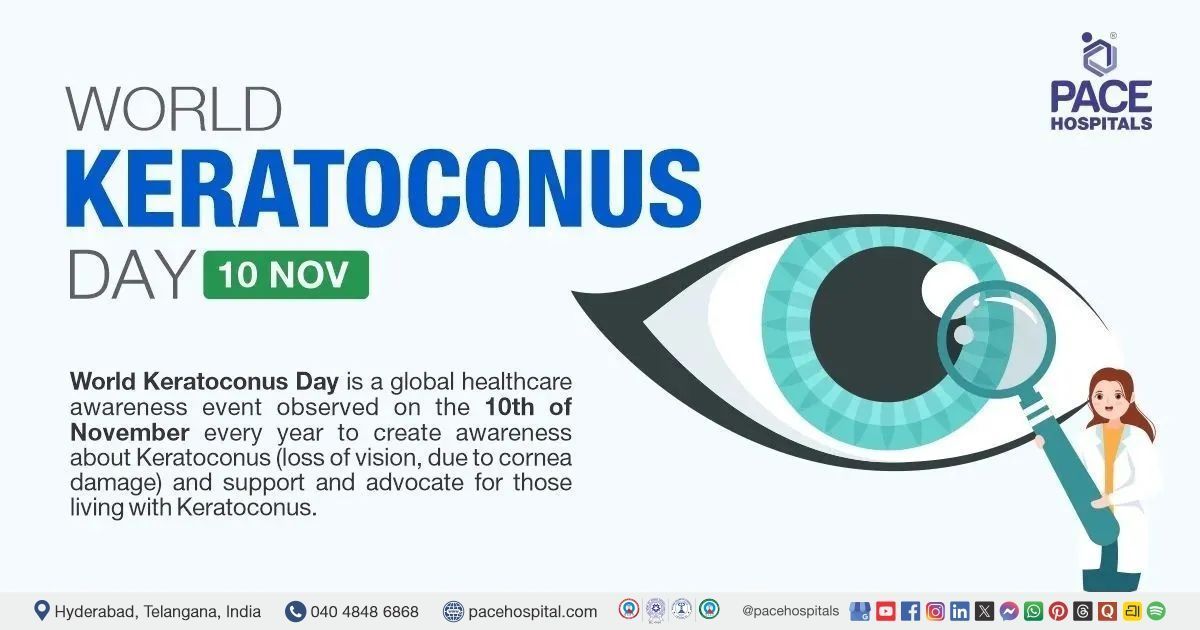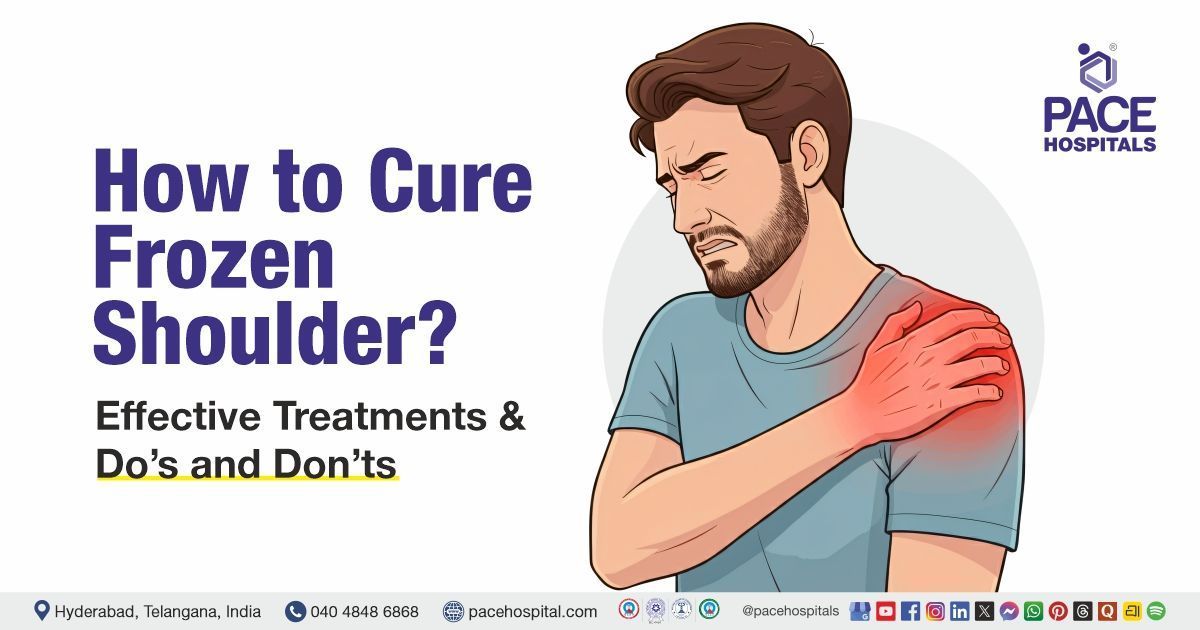Amlodipine Tablet - Uses, Side Effects, Composition, Dosage and Price
PACE Hospitals
Composition: Amlodipine tablets are formulated as white tablets equivalent to 2.5 mg, 5 mg, and 10 mg for oral administration. Each amlodipine tablet contains the active ingredient - amlodipine besylate and inactive ingredients - dibasic calcium phosphate anhydrous, microcrystalline cellulose, magnesium stearate and sodium starch glycolate.
Overview
Amlodipine is a drug given to reduce the hypertension (high blood pressure) which belongs to the pharmacologically complex drug class - Calcium Channel-Blockers (CCBs).
Amlodipine is a long-acting, dihydropyridine CCB that can be indicated for hypertension and angina. Various studies have demonstrated its effectiveness in angina pectoris too.
Amlodipine tablet uses
Amlodipine tablet is a commonly prescribed medicine in patients with high blood pressure (hypertension) to prevent the complications of high BP such as heart attack or stroke, metabolic syndrome, kidney damage, aneurysm rupture, ventricular hypertrophy, vision loss, vascular dementia, and also it is often prescribed alone or with one or two medicine.
Guidelines for taking amlodipine tablet:
- The patient is expected to read the all the medication labels and guides which come along with the medication in the packing occasionally. Doctors do regularly customize the doses and all the directions about the medications must be adhered.
- The medicine must be taken daily, with or without food.
- In case of the oral suspension (liquid) before measuring the dose, the bottle must be shaken to avoid flocculation. The blood pressure needed to be checked often.
- While initiating amlodipine or increasing the dose, chest pain may be worsened. In case of severe chest pain, the doctor must be at once consulted.
- Despite feeling well, amlodipine administration must be continued for high blood pressure. Hypertension often has no symptoms therefore lifelong blood pressure medication may be needed.
- The physician can prescribe a combination of drugs for the treatment of hypertension or heart disease. The patients must refrain from changing of doses or stopping the medications entirely without the medical intervention especially when nitroglycerin is involved.
- Amlodipine is part of a treatment regime that may also include diet, exercise, and other drugs. Therefore, diet, medication, and exercise routines must be observed diligently.
- The medication must be stored away from heat, moisture, and light.
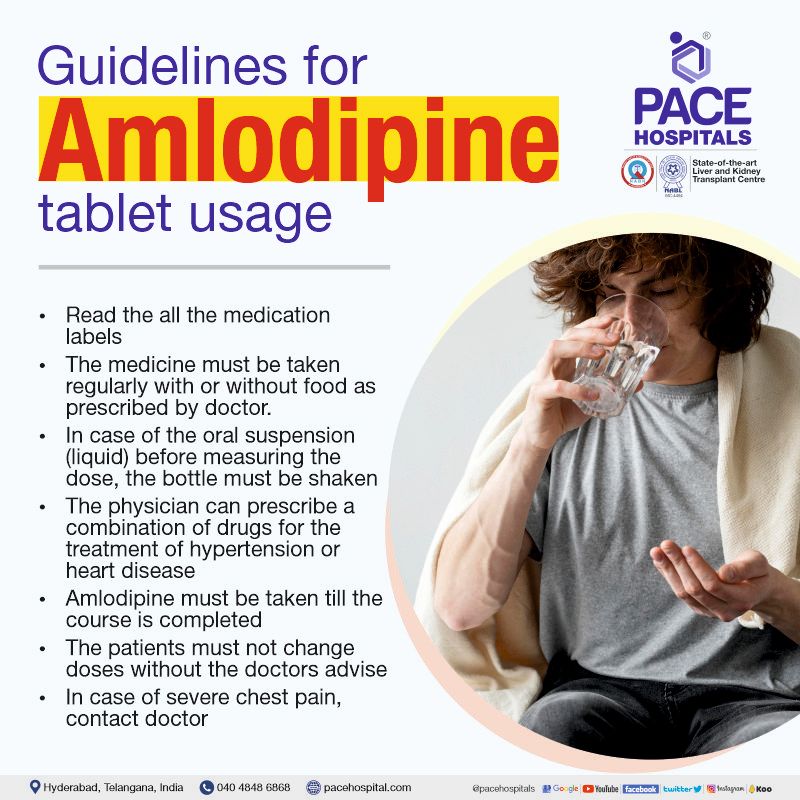
Amlodipine mechanism of action
Amlodipine tablet reduces blood pressure by a variety of mechanisms, which are explained below:
- It prevents the entry of calcium into smooth muscle cells of blood vessels (peripheral and coronary arteries) and dampens their contractions.
- Amlodipine decreases production and secretion of hormone called aldosterone and blunts the response of Ang II on blood vessels.
- Amlodipine also induces mild diuresis (increased urination) and sodium loss in the urine.
A diagnosis of hypertension is based on the mean of two or more properly measured seated blood pressure measurements taken on two or more occasions. Most patients with hypertension have a recommended blood pressure goal of less than 130/80 mm Hg.
Amlodipine indications
Following below are Indications for Amlodipine tablet:
- Hypertension (persistence maintenance of increased blood pressure) - Amlodipine is an excellent first-line choice among the multiple other antihypertensive agents.
- Chronic Stable Angina - (a type of chest pain that happens for long term when the heart muscle needs more oxygen than usual, but it’s not getting it at that moment because of any underlying heart disease. This condition can lead to acute coronary syndrome)
- Vasospastic Angina -(Prinzmetal's or Variant Angina) (chest discomfort or pain at rest and a prompt response to nitrates-type of drugs which dilates arteries)
- Angiographically Documented Coronary Artery Disease (damage/disease in the heart's major blood vessels due to plaque causing coronary arteries to narrow, limiting blood flow to the heart)
- Raynaud phenomenon
(decreased blood flow to the fingers and other extremities such as to the ears, toes, nipples, knees, or nose occurring due to of blood vessels spasm from cold, stress, or emotional upset. Spasms are sudden involuntary muscular contractions)
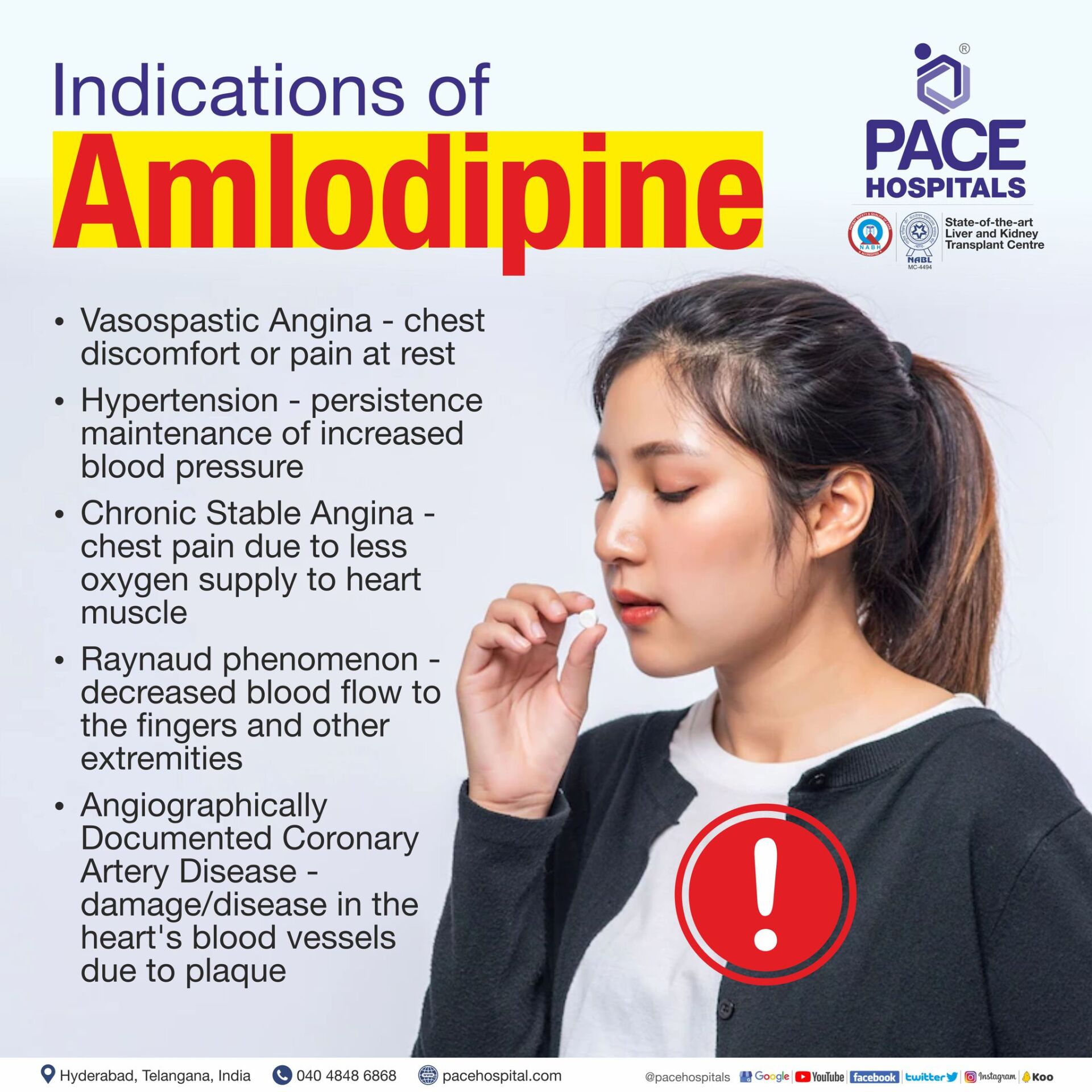
Amlodipine dosage
Amlodipine can be safely be given to children adults as well as to geriatrics (elderly public above 60 year of age).
In Adult Patients
Hypertension:
- The doctor can initiate 5 mg of amlodipine tablet once daily through the oral route;
- The maximum dose of amlodipine tablet which can be given in a day is: 10 mg
- Usually after a week or a fortnight the dose of amlodipine can be increased in 2.5 mg increments in case of unresponsive patients.
- Nevertheless, the usual dosage range: amlodipine 2.5-10 mg once daily.
Angina:
- The usual dose could range from amlodipine 5-10 mg; most patients require 10 mg for adequate effect. lower dose suggested in elderly or hepatic impairment
In Elderly Patients
In case of the elderly, low dose can be initiated and gradually increased to the optimum in case of non-responsive patients. Lower doses are preferred as the elderly have probable cases of hepatic, renal, or cardiac impairment associated. These patients also experience issues in elimination of amlodipine from the body. The doses are as follows:
- Hypertension: Oral: amlodipine 2.5 mg tablet once daily
- Angina: Oral: amlodipine 5 mg tablet once daily
In Paediatric Patients
Although rare, the current incidence of paediatric hypertension is seen about 1 in 25 youth within ages of 12-19. Paediatric hypertension is more common in youth with obesity. The dosing for paediatric hypertension given for the children within the ages of 6-17.
- Hypertension: Oral: amlodipine 2.5-5 mg tablet once daily
Patients with hepatic impairment:
In patients with mild to moderate hepatic impairment, the doctor could take extra caution, as dosage recommendations have not been yet established. Nevertheless, the physician could start at the low end of the dosing range. In case of severe hepatic impairment, initiation of treatment with low doses of amlodipine could be expected, which may be increased slowly.
Patients with renal impairment:
Changes in amlodipine plasma concentrations are not correlated with degree of renal impairment, therefore the normal dosage is recommended. Amlodipine is not dialysable.
Plasma concentrations of amlodipine aren't correlated with renal impairment, so the doctor could prescribe a normal dose. The patient must inform the doctor in case of any dialysis, as amlodipine tablet is not dialysable.
Fertility, pregnancy and lactation
Pregnancy
Amlodipine's safety during pregnancy has not been established, but demonstrated toxicity in animal studies with high doses. Amlodipine crosses the placenta. Concentration in the newborn blood is below the limit of quantification. CCB may be used to treat hypertension in pregnant woman. Agents other than amlodipine are commonly used. Females with pre-existing hypertension can continue using the drug during the pregnancy unless there is any other contraindication for the same.
Breastfeeding
Amlodipine is present in the breast milk. About 3-7% (max 15%) of amlodipine is excreted through human breast milk. Breastfeeding is usually avoided if the infant dose due to breast milk is >25%. Studies done assessing the breast mild concentration have shown no side effects in newborn.
Since the effect of amlodipine tablet on infants is unknown, the physician either decides:
- to continue or cease breastfeeding or
- to continue or cease amlodipine therapy
by taking into the account of the benefits of breastfeeding to the child and the benefits of amlodipine therapy to the mother.
Fertility
Reversible biochemical changes in the spermatozoon head were seen with amlodipine administration. The potential effect of amlodipine on fertility was insufficient. Nevertheless, the physician prescribes amlodipine only after balancing the risk benefit ratio.
Amlodipine Contraindications
The physicians do not prescribe amlodipine to patients who are:
- Suffering with hypersensitivity to amlodipine or other dihydropyridine CCBs.
- Severely hypotensive
- Experiencing shock (including cardiogenic shock).
- Suffering with high grade aortic stenosis (narrowing of the valve in the large blood vessel branching off the heart (aorta)) or other similar conditions in which the outflow tract of the left ventricle is of obstructed.
Amlodipine price list
The physicians do not prescribe amlodipine to patients who are:
- Suffering with hypersensitivity to amlodipine or other dihydropyridine CCBs.
- Severely hypotensive
- Experiencing shock (including cardiogenic shock).
- Suffering with high grade aortic stenosis (narrowing of the valve in the large blood vessel branching off the heart (aorta)) or other similar conditions in which the outflow tract of the left ventricle is of obstructed.
Amlodipine Side effects
Amlodipine can cause various side effects. The most common are:
- Ankle Swelling
- Oedema (swelling caused by excess fluid trapped in body's tissues, usually seen in feet, ankles and legs)
- Somnolence (Strong desire for sleep and feeling of drowsiness)
- Dizziness (altered sense of balance, possibly described as light-headed, feeling faint or as if the head is spinning.)
- Headache
- Palpitations (racing and pounding sensation of the heart, often bothersome)
- Flushing (face becomes red due to illness, or due to strong emotions such as embarrassment or anger)
- Abdominal Pain
- Nausea
- Fatigue
Apart the common side effects mentioned above, there are other side effects which are obtained by spontaneous reporting by either healthcare personnel or the patient themselves. A detailed list can be found below.
Organs and systems
Nervous system:
Amlodipine can cause Asthenia, dizziness, fatigue and drowsiness. There are also reports of abnormal dreams, anxiety, depression, tremor and vertigo with use of amlodipine.
Fluid balance:
Peripheral oedema - usually limited to the lower legs.
Hematologic:
Thrombocytopenia (low blood platelet count). Patients can be presented with epistaxis (nosebleed) and gingivitis (gum bleeding).
Liver:
Hepatitis has been attributed to amlodipine sometimes. Geriatric (people over 60 years of age) cases demonstrated the development of jaundice along with increased levels of aspartate transaminase, alanine transaminase, and bilirubin when amlodipine was taken for 1 month. Stopping amlodipine normalized symptoms and laboratory values.
Skin:
Erythematous (skin redness) and maculopapular rashes (rash with both flat and raised parts), skin discoloration, urticaria (a rash of round, red welts on the skin that itch intensely), dryness, alopecia (hair loss), dermatitis (skin inflammation), erythema multiforme (immune-mediated reaction causing raised, red rash), and lichen planus (inflammation of the skin and mucous membranes).
Nails:
Longitudinal melanonychia (increased melanin deposition causing black longitudinal streaking in the nail plate).
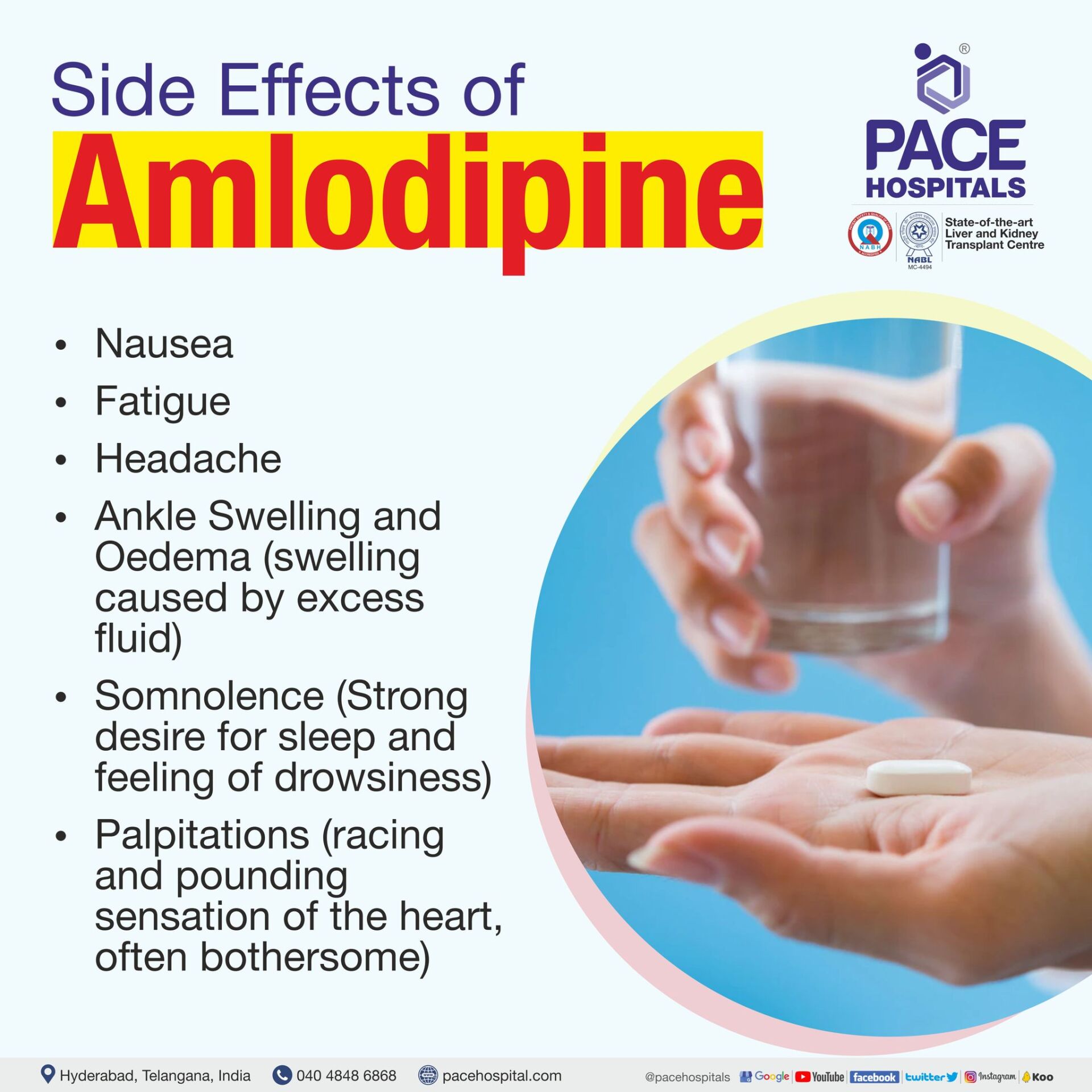
FAQs
Share on
Request an appointment
Fill in the appointment form or call us instantly to book a confirmed appointment with our super specialist at 04048486868


